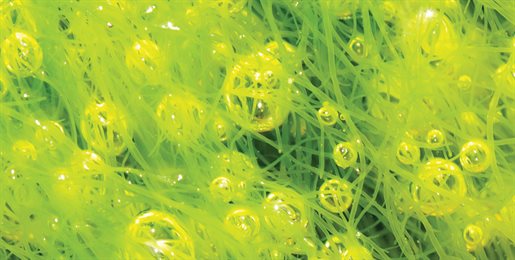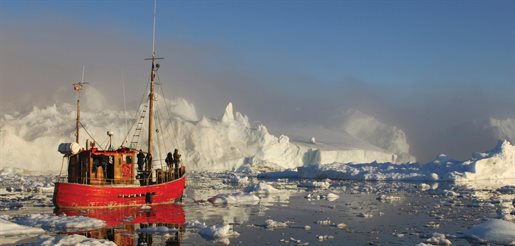Birmingham researchers are studying little-known organisms that play fundamental roles in the world's ecosystems, under threat from pollution and environmental change. Ros Dodd reports.
The 2010 BP oil spill, which saw nearly five million barrels from a sea-floor oil gusher pour into the Gulf of Mexico over three months, is considered the biggest accident of its kind in the history of the petroleum industry.
A massive clean-up operation ensued, but extensive damage had already been done to marine and wildlife habitats. Nearly five years on, the scale of that damage is still being assessed. In 2014, a study reported that tuna and amberjack exposed to the oil developed potentially fatal heart and other organ deformities.
Birmingham Fellow and marine biologist Dr Holly Bik is among scientists who haveworked on the environmental impact of the BP oil spill. But her focus was on creatures much, much smaller than fish: Holly’s main area of research is the taxonomy (defining groups of biological organisms on the basis of shared characteristics and giving names to those groups) and diversity of microbiale ukaryotes – organisms with a body size of less than one millimetre, such as nematodes (roundworms), fungi and algae – which represent the ‘dark matter’ of biology.

These hitherto ‘neglected’ organisms play fundamental ecological roles, underpinning the functioning of ecosystems in diverse environments. Species are prolific inhabitats ranging from deep-sea to the human microbiome.
Microbial eukaryotes that exist in marine sediments (living on the ocean floor) are key because, unlike organisms further up the food chain, they are fairly immobile. So in the event of environmental interference, their ability to escape is limited. Thus they are critical harbingers of long-term impacts of, say, an oil spill.
‘Some nematodes are very sensitive to pollution, while others are more resilient, ’explains Holly. ‘By looking at a species before and after an oil spill, you can see how polluted the environment is and if it’s recovering.’
Although very little pre-spill data on deep-sea biological dark matter had been recorded in the Gulf of Mexico, Holly’s team’s research, using genetic barcodes alongside morphology, showed significant changes in the structure of these organisms’ communities – even when beaches had been cleaned up.
‘The area around the oil well itself is deep sea, and sampling deep-sea is difficult because it’s remote and expensive, but we knew there had been a lot of impact around the well itself,’ explains Holly. ‘So we looked at beaches off the coast of Alabama, which were typical, diverse communities, and found a huge reduction of species. This was surprising in that the beaches had been cleaned really thoroughly after the spill – by looking at them, you wouldn’thave known anything had happened. But when you sequenced the microbes, it told a very different story.
‘Microbial dark matter provides a lot of information about environments and we are only just beginning to understand exactly what it is telling us. There could be a rippling out effect because these worms are at the bottom of the food chain, so their loss or reduction could have an impact on species higher up the food chain.’
American-born Holly, who moved to Birmingham in September 2014 after more than two years as a postdoctoral researcher at the Genome Center atthe University of California, Davis, has now shifted her research sights to the Arctic
‘We’re working on generating baseline data for marine sediment in the Arctic, where there is potential for oil and mining activities that churn up the sediment on the seabed. I’m working with researchers at theUniversity of Alaska Fairbanks and what we’re trying to do is to characterise species distributions for biological dark matter and look at how communities change over time. Are species in the Arctic Ocean the same as in the North Atlantic Ocean? Do communities change across depth and geographic areas? So really it’s about discovery.
‘There’s more and more corporate interestin mining in remote and deep-sea habitats. These habitats are very stable: they are deep, dark and slow. So any change could have an impact on them, and what we don’t know much about yet is how species of microbial eukaryotes can cope with being disturbed.’

When your passion is deep-sea marine biology, landlocked Birmingham might not seem the obvious place to pursue your research. But when cutting-edge technology in the form of high-throughput DNA sequencing and computational algorithms is central to that research, Birmingham is indeed an obvious place to come.
Instead of the traditional, time-consuming method of studying these organisms through a microscope, taxonomy has been transformed by technology, which allows scientists like Holly to do high-throughput DNA sequencing. And within the School of Biosciences is the Birmingham Biomolecular Characterisation Facility – which boasts many of the biophysical tools essential for complete biomolecular characterisation – and the Genomics Services Facility, which uses the latest next-generation sequencing technology to deliver high-throughput sequencing results in the most cost effective manner.
‘Although my background is marine biology, I’ve always been interested in genetics and DNA, because there’s so much DNA we haven’t even looked at,’ says Holly. ‘And it enhances our understanding of the natural world by looking at species at a molecular level. So I am taking advances in technology and applying them to microbial dark matter that tends to be inaccessible – in my case, species in the deep sea.’
Instead of looking at, say, 100 worms in a bowl of sediment, using a microscope, it’s possible to sample thousands or millions, from different communities, in one hit. ‘The machine we have generates 170 million sequences per single run of the instrument. In that time, manually I could do just one sample in a day. However, instead of spending a lot of time in the lab, we spend a lot of time on the computer. The data still needs analysing and that’s where the bottleneck is.’
Holly, though, is relishing the challenge to shed new light on the distribution of species of biological dark matter such as nematodes, which she calls ‘the underdogs of microbiology’.
‘Until relatively recently, they have been neglected by science; but they are important, because they are not only present in the human microbiome, affecting our health, they are present everywhere you go – in the deep sea, in the garden and on the beach – and they can help us detect the health, or otherwise, of a wide range of environments.’